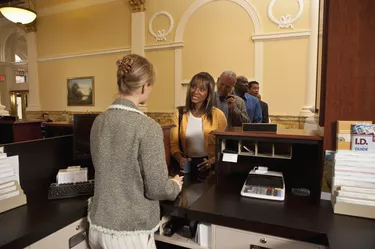
Opening a checking account is an essential part of personal finance. Checking accounts can simplify making purchases, automatic deposits, paying bills and transferring funds, among other activities. Most banks now offer free checking accounts. It is even possible to open an account without immediately making a deposit. It's important to make sure that the bank does not impose a maintenance fee, and that you will not be required to maintain a minimum balance. While almost all banks offer free checking, these accounts typically have a lower interest rate than other accounts.
Step 1
Decide what type of bank you want to use. You can choose a local bank or an online bank. Local banks generally have online banking options but also allow you to speak with someone in person in case you have questions or problems. Online banks do not usually have walk-in services, so deposits and communication will be handled over the phone or by mail.
Video of the Day
Step 2
Find the right bank. Not all banks offer free checking accounts without an initial deposit, so call to find out if the bank has the type of account you want. If you decide to use an online bank, do an Internet search until you find one that meets your needs. If you have questions about the services offered, call the number on the website and ask for a customer service representative.
Step 3
Apply for an account. Opening a free checking account is a relatively simple process. You will be required to provide identification using a driver's license, passport, birth certificate, Social Security card or military identification card. Some banks also ask for proof of residence. This can be in the form of a piece of mail, car registration or lease agreement.
Step 4
Make sure you ask the bank how long you have before making your first deposit. While you may not be required to make a deposit when you open your account, some banks require you to use your checking account within 60 days to keep it open.
Step 5
Begin banking. A debit card will be mailed to you within a few weeks of opening your account. When you are ready to make a deposit, online banks will provide you with deposit mailing envelopes, or you can electronically transfer money from another bank account if you have one. A local bank will give you deposit slips to fill out and bring in during business hours.
Video of the Day